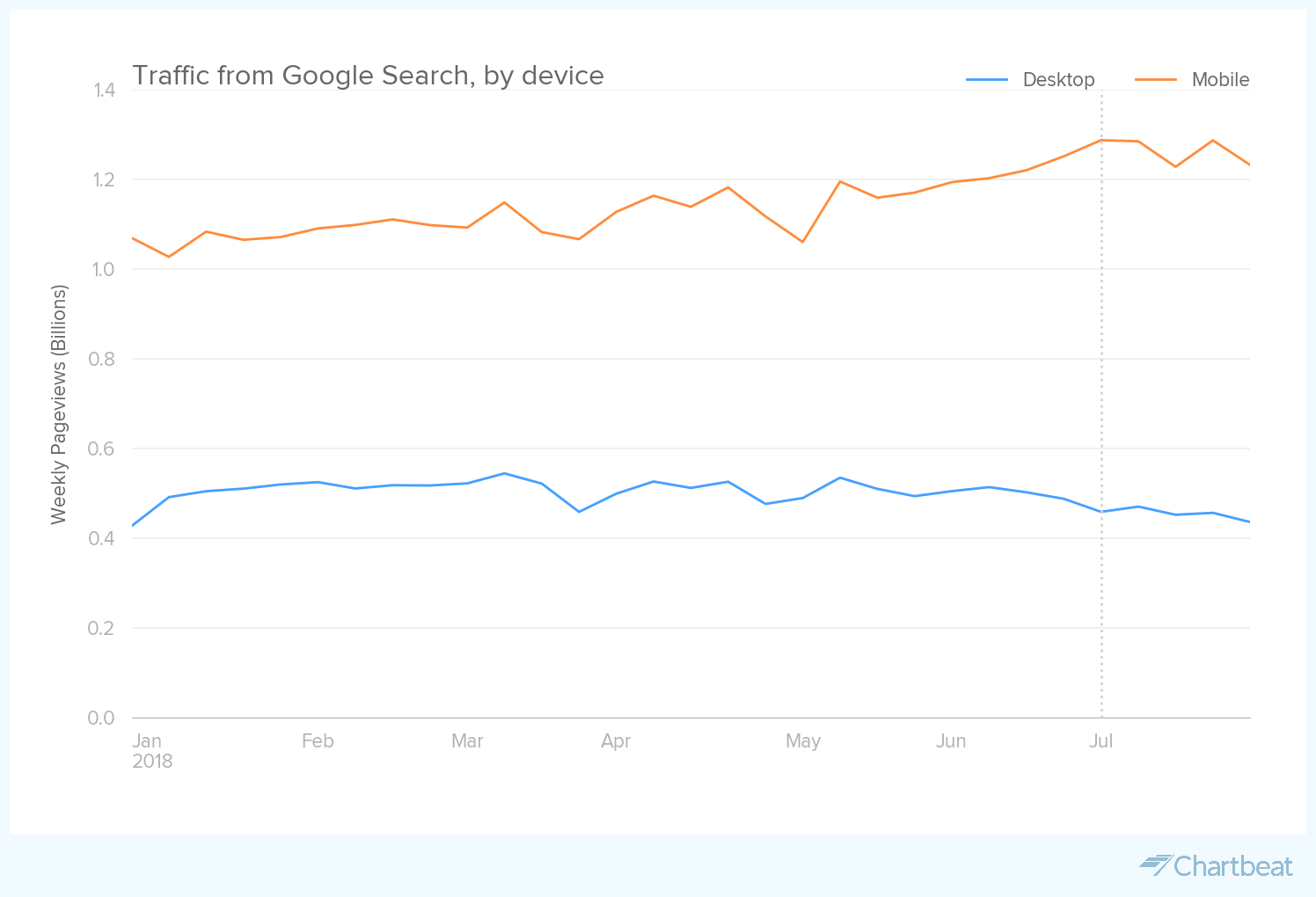A shift in the way Google views and ranks web pages may be sending more traffic to news publishers in a continuation of a trend that started early last year.
On July 1, Google switched to mobile-first indexing, meaning Google’s bots started crawling through websites as though they were seeing them through smartphones rather than desktop devices.
Since that change and other updates that looked at mobile page speed, Chartbeat told Poynter it found that 71 percent of the about 10,000 publishers it studied saw an increase in traffic that came through Google search. Compared to the previous month, Chartbeat also found a 10 percent increase in the volume of Google traffic landing on publishers’ websites from mobile devices, but an 8 percent decrease in desktop traffic coming from Google.

Since the increase in mobile traffic was larger than desktop’s decline, Chartbeat found about a 5 percent total increase in traffic arriving at publishers’ websites via Google search.

Chartbeat could not say what caused the specific increase, only that it happened after Google changed the way it indexes pages.
Search has always been one of the main sources of traffic for news sites. Social networks, apps like Flipboard and Apple News and email newsletters have diversified traffic sources over time and, in the case of Facebook, overtaken search as the primary traffic source for publishers. But Google’s return to dominance is a reminder that news organizations must focus on search.
In February, Chartbeat reported that traffic from Google search to publishers’ websites had risen by more than 25 percent globally since January 2017. This Google search growth was more than enough to overcome the decline in traffic from Facebook that came after an algorithm change to deemphasize publishers.
Google’s rise and Facebook’s fall as the main source of mobile traffic represents a revolution in the publishing world.
“There’s been this huge change in the mobile ecosystem of the last 18 months,” said Josh Schwartz, Chartbeat’s chief of product, engineering and data. “If we’d been on a call two years ago the thing I literally used to say was that mobile equals social. When someone was on a phone they were almost certainly accessing your site via social.
“In some ways it’s a fairly substantial reversal of the trend in that if you’re trying to reach a mobile audience you want to think about search first and social second,” he said. “Social is still a major component of that but it’s no longer the dominant one.”
This reversal puts more power in the hands of publishers, said Lauryn Bennett, a Chartbeat communications representative.
“As (publishers) think about being at the whim of Facebook and platforms you can’t totally control, all of these things are working toward putting more control and ownership in the hands of publishers,” Bennett said. “You can control things a bit more than hoping someone clicks on a Facebook link.”
Google search is now the majority driver of traffic to publishers’ websites on mobile devices, Schwartz said, and “that number seems to be only increasing as Google makes additional product investments on the mobile side.” Though search is far and away the largest driver of traffic, other Google products like Accelerated Mobile Pages, Google News and Google Chrome’s suggestions are also growing. Over the past few months, Schwartz said, the latter saw a 2,000 percent growth.
Search traffic from Bing, an overall insignificant source of traffic for news sites, did not see an increase during this timeframe.
Chartbeat couldn’t identify a common factor among the 29 percent of publishers who didn’t grow Google search traffic after the indexing change, but Google’s help pages suggest it may have something to do with the architecture behind those websites. Publishers whose sites are responsive or offer similar experiences on desktop or mobile should benefit from the change, but Google advises those who serve up separate sites for desktop and mobile experiences (often easy to spot through the use of an “m.” in front of a URL) to follow best practices for the mobile-first indexing bots.
Audiences interact with the desktop and mobile versions of news sites in different ways. People spend 40 percent more time engaging on a mobile homepage than on a desktop homepage and mobile readers are 20 percent more likely to click through articles than desktop readers, said Terri Walter, Chartbeat’s chief marketing officer.
This means that “there could be fundamental changes that need to happen on how we curate pages,” she said.
News publishers shouldn’t sleep on the increased traffic. Take advantage of Google's growing mobile relevancy by making sure posts look good when they show up on a search, and combine tools like Google Trends and search engine optimization techniques to write headlines that attract audiences.
More from Poynter
4 guidelines for writing SEO-friendly headlines
How headline writing and SEO collide
What to avoid when writing online headlines
9 tips for writing stronger headlines
Clarification: This article has been updated to mention other changes that Google made in the same timeframe.







